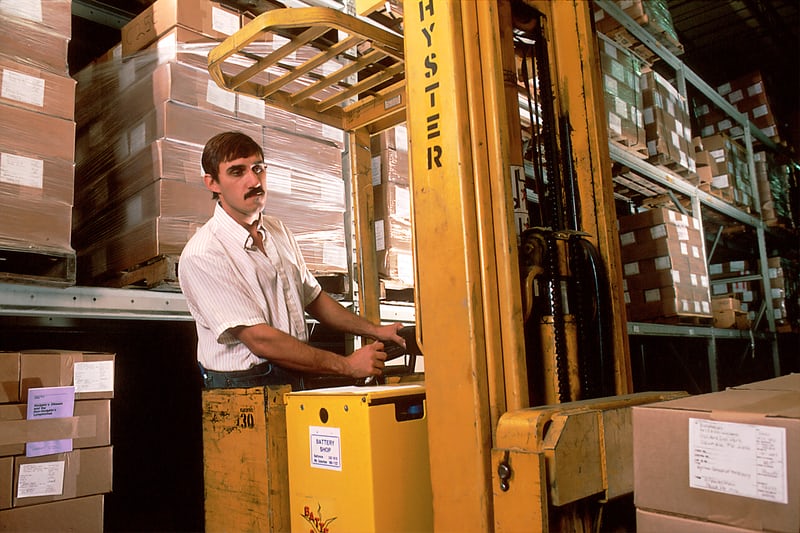How to Drive a Forklift Correctly
Forklifts are key components in all warehouse operations. They provide easy transport of goods on pallets either horizontally or vertically. Without them, major inefficiencies can occur. As useful and necessary these machines are, some of you reading may be wondering how to drive a forklift correctly. As such, this article will take you through the following:
- Why driving a forklift correctly is necessary
- How to drive a forklift
- Final points

Why Driving A Forklift Correctly Is Necessary
Driving a forklift may seem easier than driving a car as there are no major road signs or other drivers which could possibly cause congestions around the warehouse. However, driving a forklift is slightly more technical than some people initially perceive. After practicing how to drive and learning how to handle the forklift, operators will be able to lift and carry heavy loads with ease while also adhering to the health and safety standards enforced by the HSE. Furthermore, it is also absolutely pivotal that operators know how to drive a forklift correctly as failure to do so could result in fatally hazardous scenarios in the workplace.
As such, having sufficient training and knowledge on how to operate these types of machinery is crucial for the success of any warehouse and transporting business.
How To Drive A Forklift :
Now that we know why it is vital to drive a forklift correctly, you may be asking “How to drive a forklift?”. It is important to note that operating a forklift is like any other complex task. If you break the task into smaller manageable pieces, it is much easier to understand. Below we have listed the steps to drive a forklift correctly as well as the different parts of a forklift to help you operate these handy machines safely and effectively.
Seat Belt –
The first step on how to drive a forklift correctly is not to do with the machine itself but to do with safety. Operators need to enter the cab of the forklift by holding onto the frames of the forklift and must strap themselves in with a seat belt. This is obviously to make sure drivers do not fall out when turning the vehicle and can help you remain in the forklift should a sudden crash occur.
Locate The Key Switch And Emergency Stop Switch –
Once strapped in, operators will need to know where the ignition key switch and emergency stop switches are. This is so they can initially start up the engine of the forklift as well as know how to stop the vehicle immediately should an emergency arise.
Lift Forks Of The Ground –
Once the engine is on, operators will need to lift the forks of the truck approximately 3-6 inches off the ground with the control levers so they don’t scrape the floor while driving. It is important not to exceed this suggested height limit when initially starting the machine as it could be a major hazard around the warehouse, equally having the load below 3 inches could mean that certain obstacles can still hit the forks and potentially damage them.
Release Emergency Brake –
Now that the forks are elevated, you’re almost ready to start driving. Before releasing the emergency brake (which should always be set every time a forklift is parked) press the brake pedal with your foot otherwise the machine may suddenly move. In addition, make sure your pathway is clear before moving by looking in your direction of traffic. Sound your horn if your vision is obstructed to alert others of your presence.
Change Shifter –
Use the shifter to change the direction you’re driving. Push the shifter away from to drive in a forward direction or pull it back if you want to go in reverse. Keep your foot on the brake pedal while you shift so you don’t move around. Always make sure that you put the shifter back into the middle position to change it into neutral.
Press The Accelerator Pedal –
Just like a car, to drive the forklift, press on the accelerator pedal located on the right hand side beneath the steering wheel. Make sure you lightly tap on the pedal as a heavy foot can cause the forklift to speed off uncontrollably. Maintain a slow speed at first until you’re used to handling the machine.
Steering Wheel Knob And Direction –
Most forklift steering wheels will have a knob installed on it. This is to have better control when steering the wheel in the direction you want it to go. Make sure to have smooth and careful handling when steering the wheel. Having jerky or forceful movements will cause your forklift to potentially have a shift in the centre of gravity and as such, may lead to the forklift toppling over. Read our blog to find out the most common causes of a forklift tip over for more information.
Final Point
Now that you have a better understanding of how to drive a forklift correctly as well as the parts of a forklift which helps you steer and move in the direction you want, it is important to stay vigilant and aware of those in the operating area. Be sure to look in all directions before you begin operating a forklift, make use of your rear view mirrors and drive slowly inside and out of any warehouse settings.
